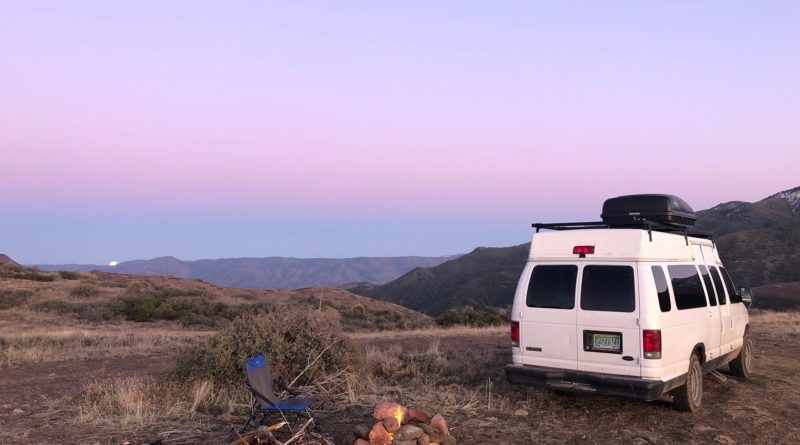A Van & A Plan
“Remember this,” I told myself. The side doors of our newly-converted van opened into the final hour of September daylight, channeling summer’s last whisper of a warm breeze.
Inside, a years’ worth of imagination and parts had finally culminated in something whole.
Streaks of sun lit up the details: the live-edge cherry countertop, the neat blue curtains that kept our clothes from toppling as we drove down rough dirt roads, the bedside window that would soon frame the forests, mountains and lakes of 27 states.
Outside, sailboats bobbed on Lake Willoughby. My boyfriend, Takoda, and I exchanged knowing smiles. For the first time in our lives, we had no idea what tomorrow might hold.
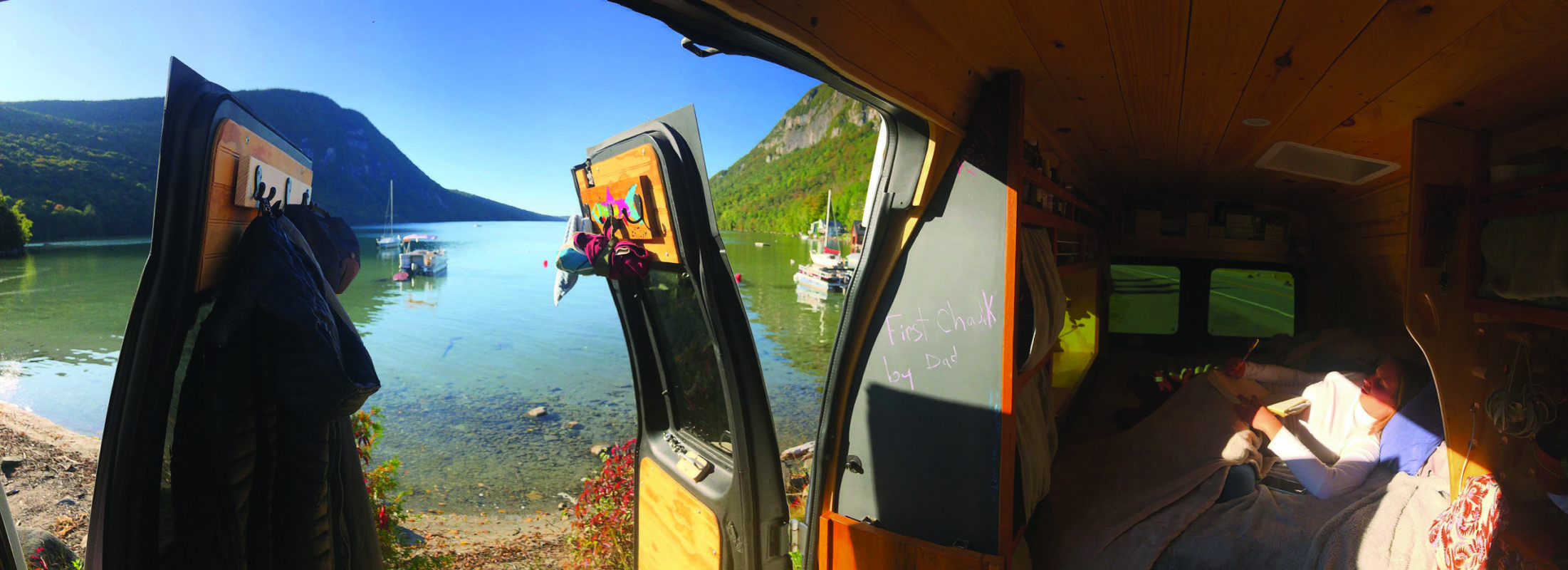
We’d begun imagining this moment two years earlier when the “vanlife” idea stuck in our heads like gum sticks to your shoe. Neither of us remembers how the conversation started. We loosely followed the #vanlife movement on Instagram, and though we knew our reality would be far from the carefully-designed images of $100,000 Sprinter vans parked along the California coast, those photos hooked us.

The freedom represented in the pictures felt achievable, even on a down-scaled budget. Vans became the go-to topic of our long-distance phone calls; Takoda lived in Florida at the time. I was in Middlebury, Vt. Once we decided, we never second-guessed ourselves.
The months preceding our departure saw a blend of restaurant work, sawdust and engine grease. Takoda’s father had been a professional woodworker for many years, and he transferred his skills and attention to detail to his son. His woodshop in Waitsfield became our home base, the place where our sketches of cabinets and tables and shelves would take physical shape.
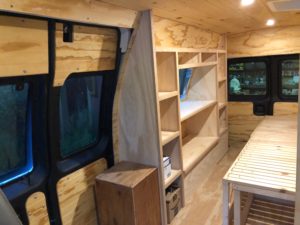
At night, we’d sit in the van’s empty metal shell and discuss storage options for hiking boots, hammocks, fishing rods, formal wear for two upcoming family weddings. Which window to keep open and which to insulate. Where to find a mattress that folds. How big the freshwater tank should be. Whether our 2003 Ford E250 ambulance-turned-tiny-home could make it across the country at all.
We were naive. Funding the van’s initial purchase ($4,000), mechanical work ($7,000) and conversion ($9,000) required us to fill and empty our bank accounts, several times over. We quit jobs we’d lusted after to wait tables and bartend. We said the conversion would take a few months; it took a year.
Throughout the process, I have asked myself: Why? Why run away from a stable life in a beautiful part of the world to live in 60 square feet with no bathroom?
Well, there are the obvious reasons: skiing, hiking, fishing, mountains, oceans and freedom. The wistful look on every person’s face when we tell them about our travel plans. “Now’s the time to do it,” they say. At a campsite outside Newport, Vt., a woman looked at our van, looked at us, and called out, “enjoy your dream.”
There are murky reasons, too. As a college junior, I traveled abroad with a friend. She died in a hiking accident halfway through our trip. The following semester brought a full course load, a position as editor-in-chief of our student newspaper, a resident advisor position, a senior thesis, and a woefully inadequate amount of sleep.
After college, I won my dream job writing in Vermont, as an editor at this magazine.
But life’s inevitable moments of darkness—the death of the family dog, the death of my grandmother—were like individual nails hammered into shoddy plaster, creating a crack in my mental health that became increasingly difficult to patch. I wanted something new, something distracting, something completely bereft of obligation, something I could control.
Takoda had earthlier reasons for choosing life in a van: a restlessness at his nine-to-five, where he monitored oyster populations for the state of Florida, a hunger for adventure and a curiosity about his next step. After college, he had embarked on a three-month road trip that connected the dots between the country’s wildest fly fishing spots. He wanted to revisit his favorites, add more to the list, and, like me, he had a hankering to explore the American West.
Always the yang to my yin, he gave the best answer when I asked recently why he had wanted to hit the road.
“I don’t know,” he said, flashing a wry smile. “Why not?”
BABY, IT’S COLD INSIDE
A wise bartender told me that we should double our expected timeline for van renovations. He was correct, and then some. While we hoped to start our trip at the beginning of summer, our September departure sent us through the northern U.S. in the dead of winter. Van lesson number one: In the winter, go south.
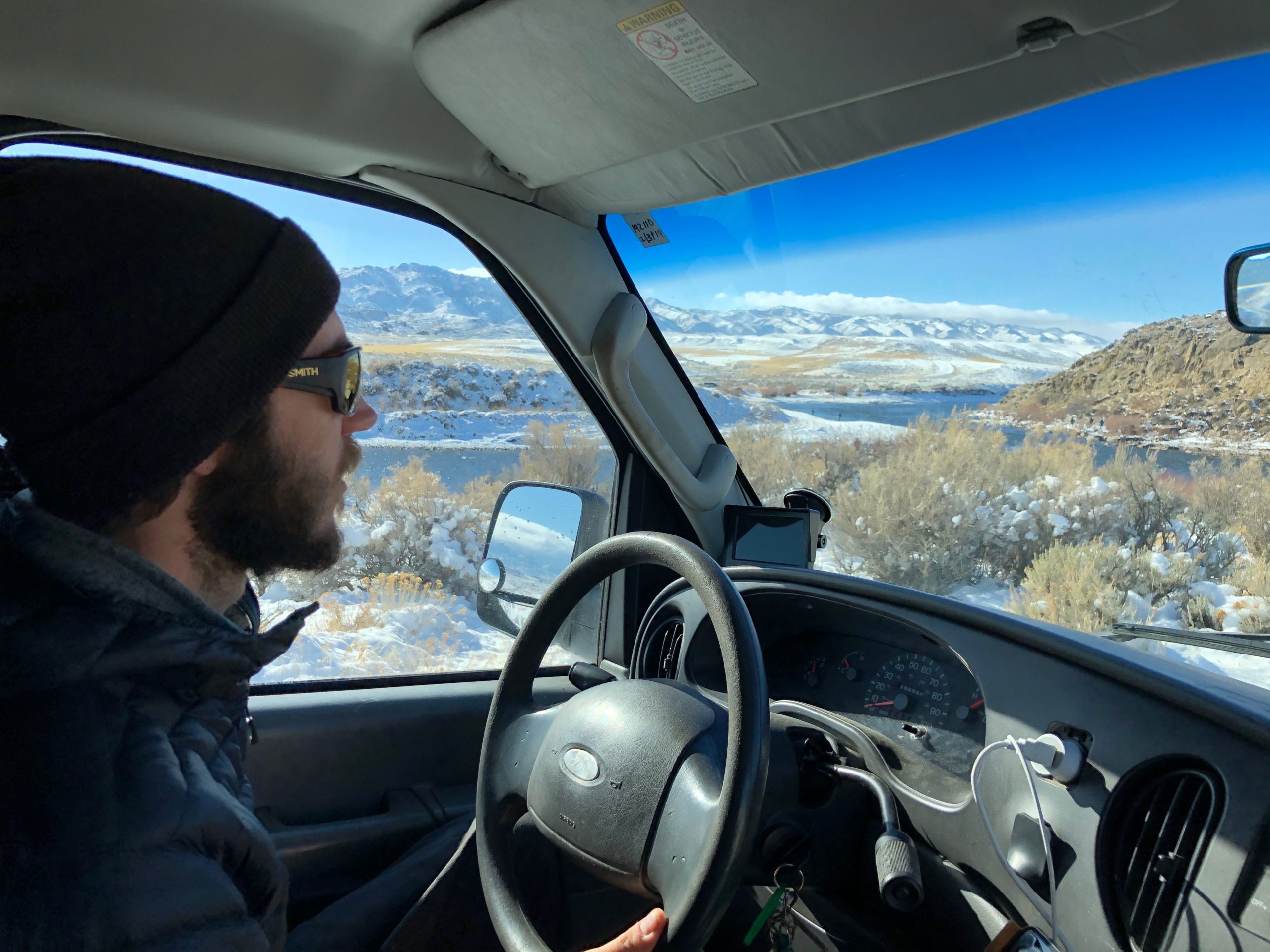 Flash forward to a night parked outside a Planet Fitness (where our membership counted more for showers than exercise) in Rochester, Minnesota, a pit stop between the Great Lakes and Badlands National Park. Early November brought an unexpected cold spell through the Midwest. We expected 20-degree weather but got -5 instead.
Flash forward to a night parked outside a Planet Fitness (where our membership counted more for showers than exercise) in Rochester, Minnesota, a pit stop between the Great Lakes and Badlands National Park. Early November brought an unexpected cold spell through the Midwest. We expected 20-degree weather but got -5 instead.
Aside from a faulty heater system whose maximum setting produced a lukewarm breeze, the van was well-equipped for the cold. We had layered puffy pink batt insulation above the ceiling, laid hardboard insulation under the floorboards and stapled Reflectix to wooden furring strips behind the walls. We hung a giant fuzzy black-out blanket between the cab and cabin. Our body heat kept the van comfortably warm in most circumstances; we both loved sleeping when it was 30 degrees outside.
But negative temperatures were a different story. Cold seeped through the cracks in the doors and the uninsulated window panes. We remained still throughout the night for fear of touching frigid parts of the mattress that had not been warmed by body heat. The comforter where we pulled it up to our faces, froze into a chunk from our breath’s condensation.
In the morning, our freshwater tank was frozen solid; no hot coffee, no oatmeal. We had carefully chosen hearty house plants to accompany us on our journey with hopes they’d survive the country’s diverse climates. Now all five hung limp. The van’s interior metal and glass surfaces hosted layers of crystallized breath. And buying breakfast at a local cafe only reminded us of our dwindling funds. We sat our creaky bones down at a table and stared at each other glumly. “What are we doing?” we asked each other. “Is this too crazy?”
“Maybe we should think about selling.”
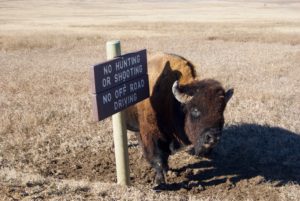 That day’s five-hour drive to Sioux Falls, South Dakota, felt like a chairlift ride. Though clad in a winter jacket, hat, gloves, and draped in blankets, Takoda still felt his feet go numb from extending a limb to press the gas pedal. We later realized that holes between the engine compartment and the cab sucked in the outside air.
That day’s five-hour drive to Sioux Falls, South Dakota, felt like a chairlift ride. Though clad in a winter jacket, hat, gloves, and draped in blankets, Takoda still felt his feet go numb from extending a limb to press the gas pedal. We later realized that holes between the engine compartment and the cab sucked in the outside air.
Van lesson number two: Stuff any engine compartment holes with Shamwows to prevent icy breezes on your feet.
We spent that evening thawing ourselves over tea and $6 bottomless soup at an Olive Garden before nestling into another Planet Fitness parking spot for round two.
NOTHING BAD ABOUT THE BADLANDS
We woke the next morning with the comforting knowledge that we were heading toward 50-degree weather, but questions lingered from the day before. Did our lack of financial resources, combined with the impending winter season, make our plans unwise—even unsafe?
The drive through the endless grasslands of South Dakota was quiet. While I eagerly anticipated the Tetons and Zion and the Grand Canyon, I didn’t know what to expect from the Badlands—I hadn’t heard much about the park before our route sent us through the Midwest.
But we sat up in our seats as the grasslands dissolved to canyons that rose again in razor-edged ridges of stone. With windows down, letting in some much-needed warm air, we watched the sun inch toward the horizon, adding a golden hue to the streaks of red, purple, yellow and grey. The Earth looked so different within the National Park than it did outside. I had never seen geology behave this way.
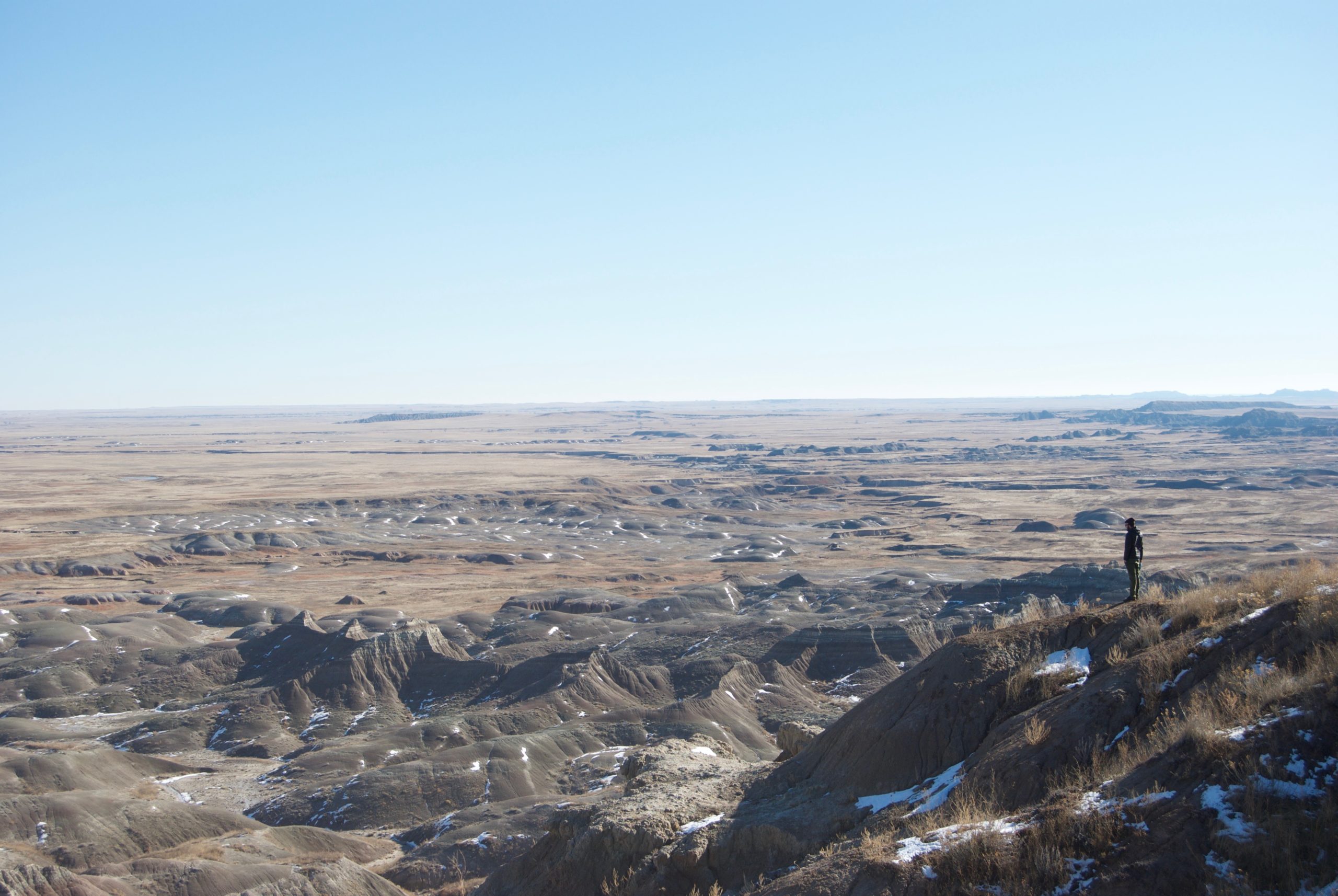 We had stopped for a photo when we heard sharp clicks on the pavement behind us. We turned to see a big-horned sheep strolling casually up the road, and our mouths fell open as he sauntered by, five feet from our open window. We sat in awe, watching his white rump make its way toward the sunset.
We had stopped for a photo when we heard sharp clicks on the pavement behind us. We turned to see a big-horned sheep strolling casually up the road, and our mouths fell open as he sauntered by, five feet from our open window. We sat in awe, watching his white rump make its way toward the sunset.
Okay, Badlands.
The road to our free campsite, located just outside the park boundary, wound us through forty minutes’ worth of peaks and valleys. We arrived and cooked our favorite quick meal— “fancy” Top Ramen with chopped kale and a poached egg. Full, warm and happy, we exchanged the same knowing smiles we’d sported at Lake Willoughby.
Maybe we wouldn’t sell.
AND THEN THE PANDEMIC
From November to April, the van brought us to snow-capped mountains, hot springs, trout-filled streams, ponderosa pine forests and national parks where the cold warded off the usual crowds. We attended family reunions, became regulars in small-town coffee shops and swapped travel stories with other van dwellers. We witnessed the marriage of Takoda’s brother in December and my brother in January. We visited all of our living grandparents.
We fell in love with red dirt and 20-foot cacti and the way the desert flowers bloom after a few hours of rain. We saw eagles and bison and elk and wolves and moose. We learned to live within our means, which were constantly replenished by family and friends who unconditionally supported the arguably irresponsible lifestyle we had chosen.
And we drove through devastated native reservations. We tuned into local radio and heard about the scores of missing and murdered indigenous women whose cases have been left uninvestigated. We learned that Mount Rushmore was built on land stolen from the Lakota Sioux Tribe. We attended film festivals that showcased the threats our public lands face from over-tourism and natural resource exploitation. We vowed to carry what we saw forward into whatever shape our lives would take—proof that unfamiliar worlds always exist outside our own bubbles.
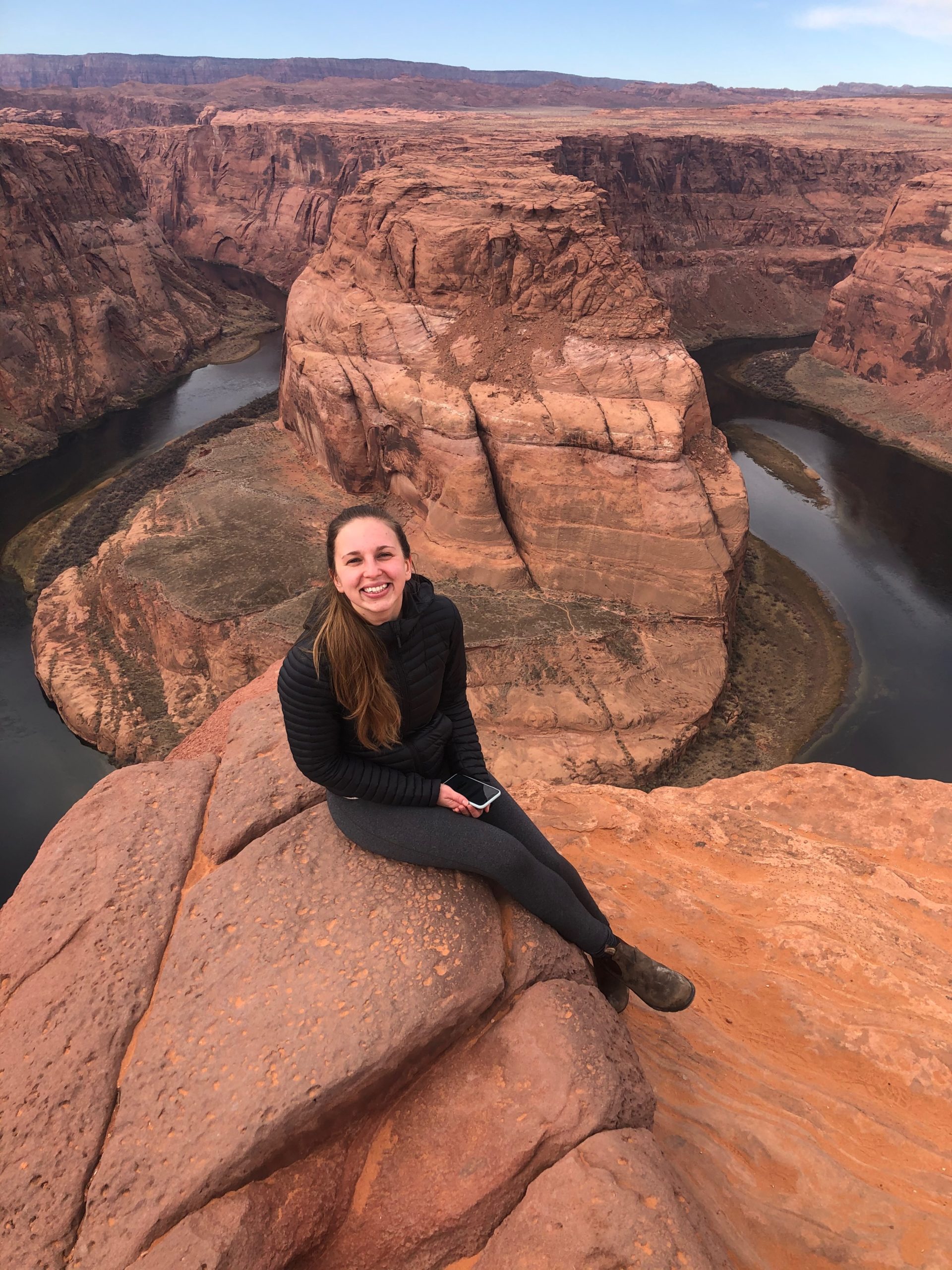
In March, we stayed for a week at a friend’s ranch in a remote part of New Mexico, where we had no service or internet. We emerged to a changed world. The coronavirus had reached American shores, and it was spreading fast. A friend we planned to visit in Denver asked if we could pick up toilet paper in Durango because all of Denver’s grocery stores had run out. I told her we would stock up, only to find Walmart’s entire paper goods aisle completely empty as well.
At first, we felt perfectly equipped to handle a quarantine order. We imagined ourselves heading south to a warm wilderness paradise, stocking up on supplies, and staying there. Southern California? Moab?
But the realities of the impending pandemic prevented any morally acceptable travel. States started issuing shelter-in-place orders. Campgrounds and state parks shut down. Planet Fitness temporarily closed its doors and froze its memberships. Moab issued a warning, telling visitors to stay away.
 To get some thinking space, we drove from Denver to a free campsite on Lake Meredith in northern Texas. Parked on cliffs overlooking the lake, we both called our folks.
To get some thinking space, we drove from Denver to a free campsite on Lake Meredith in northern Texas. Parked on cliffs overlooking the lake, we both called our folks.
“Everyone’s dreams are getting canceled right now,” my dad said. “I think you should come home.”
On March 23, the widely-respected van blog, Gnomad Home, issued a call: “If you have somewhere to go, if you have a place to shelter, if you know family or friends or a good samaritan who is willing to put you up for an indefinite amount of time – GO THERE. AND STAY THERE.”
So many vanlifers tell tales of failed engines, busted tires and getting lost. Our misadventure was COVID-19. On March 25, we left Texas for Vermont.
But, as I sit in a sunny room at my parents’ house in Middlebury, I only feel lucky. The trip may have been short, and it may have been cold. But it happened. We worked together to carry out an impossible goal. We made friends, experienced new places and reconnected with loved ones. We took time for ourselves. In so many intangible ways, we are different now. And the van sits close by in the driveway, ready for its next adventure.

